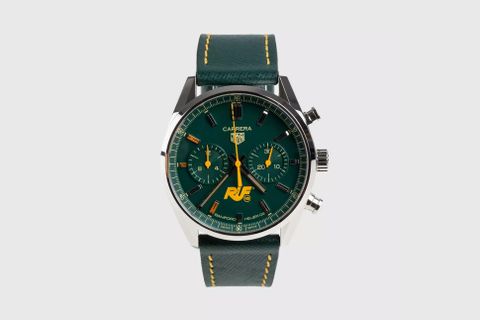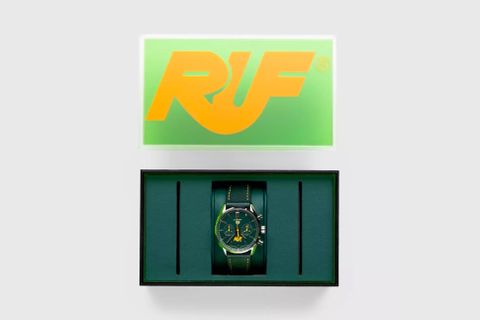The TAG Heuer Carrera Enters A New Era for its 60th Anniversary
To celebrate a 60th anniversary the tradition usually is to gift silver, but the TAG Heuer Carrera has remained the gold standard in chronographs. So they are delivering this classic beauty of the watch world in two new iterations, the 2023 ‘Glassbox’ update of the TAG Heuer Carrera Chronograph.
But before we go into the new releases, let's touch on the omnipresence of the TAG Heuer Carrera over the last six decades.
Way before Aime Leon Dore, Kith, and Virgil Abloh, there was a young entrepreneur also interested in blending all the spirit, culture, and aspiration of motorsports to the world of lifestyle. His name was Jack Heuer. Great-grandson of founder Edouard, young Jack had a penchant for racing. As a company, Heuer was already well acquainted with the racing world, supplying dash-mounted chronographs and stopwatches to many competitors and races. But Jack saw a gap in the market for a timepiece that appealed to the racing drivers of the time. Odd market to corner, you may think, but the “gentleman drivers” of the ‘50s and ‘60s were the Basketball players of the time, eating up the gaze of the sartorially sensitive; they set the trends in menswear. Heuer was, in fact already making wrist chronographs, but they were a cluttered affair, strictly for tool use. No style. In essence, Jack wanted to take the existing wrist chronograph but make it clean as hell. A piece of sleek, subtle, and minimal architecture for the wrist.
Like Braun’s Dieter Rams, Jack was a disciple of “Good Design.” The Carrera preceded Ram’s ten commandments of Good Design by nine years. Yet the watch was innovative, unobtrusive, aesthetic, useful, and honest. Jack was not just a nepo kid with a company thrown into his lap to do with as he pleased. He understood design and engineering. Having studied at the renowned Swiss Federal Institute of Technology in Zurich, he had a savantish interest in the works of some of the finest modernist designers and architects of the time. Ray and Charles Eames, Oscar Niemeyer (Jack even visited Brasil to visit the architect's work in person), and Ludwig Mies van der Rohe were all names Jack studied and admired. One thing they all had in common was their belief in the “less is more” aphorism. Architect Van Der Rohe’s love for clarity and simplicity and Niemeyer’s joy in free-flowing, sensual curves in particular, can be seen combined in the Carrera language.
One of the key design traits Jack wanted to portray in the Carrera was legibility. He began by removing any unnecessary elements and focusing on the crux of the watch, the chronograph functionality. From release, Jack was always tinkering to perfect the Carrera. Increasing the watch's legibility when driving at high speeds led to the evolution from a mostly silver to a two-tone “reverse panda” colorway in the early ‘70s (way ahead of the dunks). Jack also managed to source a new innovation from a watch crystal manufacturer. A steel tension ring allowed the watch crystal to be held in place in a way that increased its water resistance. Jack being the minimalist, he wasn’t just going to have a steel tension ring cluttering the face for no reason, so he gave it an additional use. He decided to mark the tension ring with the essential 1/5 second demarcations, thus creating an even cleaner face. All encased in 39mm beauty, the Carrera's clean lines and simple appearance were perfectly suited to the popular modernist sartorial stylings of the time. With today’s desire for clean palettes and sophistication in subtlety, it still wins, 60 years on.
Design done. Now for the marketing. Ahead of his time again. Frequent readers of Highsnobiety may remember we caressed the marketing expertise of the Carrera before. But I will remind you a little. As mentioned, Jack was a race fan, and in 1962 as a guest of Ferrari, he sat trackside for the 12-hour Sebring race with two of motorsport's big faces of the time, the Rodriguez brothers. The brothers got to talking and told Jack of a race they used to take part in called the Carrera Panamericana. By 1962 defunct, it was one of the high adrenalin races to have ever taken place, running on the open road and spanning the length of Mexico. The race, as we know, was also an inspiration for Porsche. With thoughts of the dangerous, charismatic, speed-addicted, and stylish drivers that took part in the race, Jack returned to Switzerland to put a watch to the name, and a legend was born.
For the 60th anniversary of the Carrera, TAG Heuer is evolving the classic model for a new era of watch enthusiasts. Using the fan favorite 39mm stainless steel case (for universal wearability) as its base, the chronograph is domed beneath a sapphire crystal ‘glassbox’. Carrera enthusiasts will be familiar with this look as it bears familiarity with the domed hesalite crystals used on ‘70s models. But to mark this special occasion TAG Heuer has returned to Jack’s modernist inspirers to give the Carrera an even sleeker finish. The crystal has been re-engineered to have a curve that flows seamlessly over the tachymeter scale, running around the dial edge and into the case. Jack will also be happy to see that the flange and indexes have been further curved. In keeping with the “good design” philosophy, this aesthetic treatment is also useful. The extra curve means the tachymeter can be read from practically any angle.
With 60 years of history to its name, its hard to pack in all the ‘greatest hits’ attributes that have accumulated to make the Carrera such a mainstay icon. Nevertheless, TAG Heuer has done its best to tick some off some of the key moments in its history without losing its “less is more” integrity. This has been done partly by splitting these nods to the past across the two releases.
First up is a signature modern-feeling blue dial on a blue calfskin leather strap. This piece references the 1969 Heuer Carrera "Chronomatic." The first of its kind with a blue dial and, more importantly the first automatic chronograph on the market. Hence the fantastic copywriting job on the name. Keen eyes will also notice the date window situated below the dial, another key change the “Chronomatic” brought to the Carrera.
The parallel release is the ‘reverse panda’ in a classic black and silver iteration, an ode to the racing heritage of the Carrera. This piece references the 3147 “Dato 12” the first Carrera to feature the calendar window. A function that cemented its place in the lifestyle sphere beyond the needs of drivers (who didn’t really need a date function). In a time when a little look of luxury and owning something with a growing patina over age is desired, its black perforated calfskin leather strap is something of beauty. The fact it is a reference to the 2447 NS, one of the rarest and most sought after Carrera ever made is an added bonus.
TAG Heuer has also evolved the Carrera under the hood. Inside both new timepieces is an updated version of its in-house automatic chronograph calibre, the Heuer 02, aptly named the TH20-00. Visible through the sapphire crystal case backs, TH20-00’s movement (overseen by TAG Heuer’s Movements Director Carole Forestier-Kasapi) features an oscillating weight that results in bi-directional winding (great for all you left-handers). It also promises faster winding, keeping the watch closer to its max 80-hour power reserve and improving its precision even more.
There is a reason that mid-century design is popping right now and will continue to, beyond any tiktok #. In the right hand's design can be understated and well, really useful and functional. That’s why names like Eames, Rams, and Heuer stand the test of time. They designed with the user in mind, for longevity, and above all, with style. Too often, brands mess and meddle with their timeless classics, offering them out for meaningless collaborations or adding tacky gimmicks. Not TAG Heuer, they stick to the essentials and evolve them.
Head here to own the next chapter of TAG Heuer's history, The TAG Heuer Carrera Chronograph 39mm.

